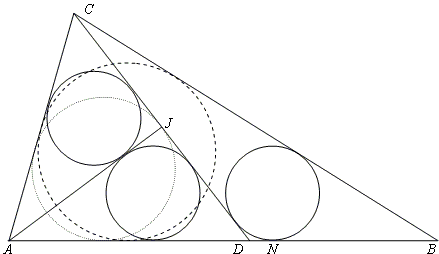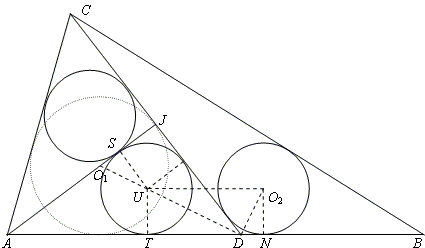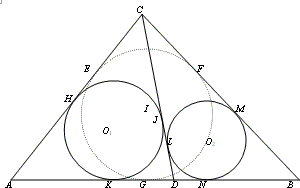A better solution to a difficult sangaku problem
J. Marshall Unger
Department of East Asian Languages & Literatures
The Ohio State University
PROBLEM. In ΔABC, AB = BC. If one chooses D on AB and J on CD such that

SOLUTION
The trick to solving the problem expeditiously is to clarify what is given and to prove the converse proposition first.
Notice that the only connection between
In the figure above, let a, b, d, and h be the lengths of CD,
| 1. | a - b | = 2d |
| 2. | 2 r1r2 | = ad |
Given h = 4r, square the equation for the inradius of a right triangle:
Now area( ΔACD) = ha/2 = 12r² = r1s, where s is the semiperimter of ΔACD or 8r. Thus ![]()

From this, it is clear that solving the original problem comes down to proving, without knowing the value of h, that ΔACJ and ΔADJ are 3:4:5 right triangles.
It's easy to show that ΔDTU is similar to ΔDO2U. Hence DU is the mean proportional between DT and
| a/2 - r + d | = [r² + (a/2 - r)²] / (a/2 - r) | |
| (a/2 - r)² + d (a/2 - r) | = r² + (a/2 - r)² | |
| d (a/2 - r) | = r² | |
| ad/2 - dr | = r² | |
| r1r - dr | = r² | |
| r1 - d | = r. |
(Lemma 2 takes the form 2r1r = ad since we are assuming
Hence, by Lemma 2, 2rr1 = 2(2d)(3d) = 12d² = ad, so a = 12d = 6r. Since ![]()
The lemmas follow from the general case of any triangle ABC with incircle I. Draw a cevian CD and the incircles O1 and O2 of the resulting triangles ACD and BCD. Label the points of tangency of these incircles as shown. Then

PROOF: By equal tangents, CE = CF (1), and
| AE = AG | BF = BG | CM = CL | DJ = DK | ||||||
| AH = AK | BM = BN | CH = CJ | DN = DL. |
Subtracting the equations in second row from those in the first, we get
| EH = GK (2) | FM = GN (3) | CM - CH = JL (4) | JL = DK - DN (5). |
Equating the left and right sides of (4) and (5),
| CM + DN | = DK + CH | |
| (CF + FM) + DN | = DK + (CE + EH) | |
| (by 1) FM + DN | = DK + EH | |
| (by 3) GN + DN | = DK + EH | |
| (GN - DG) + DN | = (DK - DG) + EH | |
| 2DN | = GK + EH | |
| (by 2) DN | = GK (6). |
Linking equations (2) and (6), EH = GK = DN. ![]()
Many more inferences can be drawn from this figure, but we need just two.

Lemma 1 follows immediately if E and J are the midpoints of AC and CD, respectively. Then
Lemma 2 in the general case is
(r1 + r2)² + (DJ - DL)² = (O1O2)² = (r1 - r2)² + KN²,
but KN = DK + DN = DJ + DL by equal tangents. The rest is just algebra.
In introducing the solution of Kitagawa Moko (1764 -1833), Fukagawa and Rothman remark, "It is somewhat complicated and we hope that readers can find a simpler one." I do not know whether the solution presented above is what Fukagawa and Rothman had in mind, but Kitagawa's solution is certainly complicated. It proves Lemma 1 relying in part on the given that ΔABC is isosceles; finds expressions for r1, a, and d in terms of r and h; plugs these directly into Lemma 2; produces a third-degree equation in r and h through more painstaking algebra; rejects the roots
References
- H. Fukagawa, A. Rothman, Sacred Mathematics: Japanese Temple Geometry, Princeton University Press, 2008
- R. Honsberger, Episodes in nineteenth and twentieth-century Euclidean geometry, MAA, 1995
Sangaku
- Sangaku: Reflections on the Phenomenon
- Critique of My View and a Response
- 1 + 27 = 12 + 16 Sangaku
- 3-4-5 Triangle by a Kid
- 7 = 2 + 5 Sangaku
- A 49th Degree Challenge
- A Geometric Mean Sangaku
- A Hard but Important Sangaku
- A Restored Sangaku Problem
- A better solution to a difficult sangaku problem
- A Simple Solution to a Difficult Sangaku Problem
- A Trigonometric Solution to a Difficult Sangaku Problem
- A Sangaku: Two Unrelated Circles
- A Sangaku by a Teen
- A Sangaku Follow-Up on an Archimedes' Lemma
- A Sangaku with an Egyptian Attachment
- A Sangaku with Many Circles and Some
- A Sushi Morsel
- An Old Japanese Theorem
- Archimedes Twins in the Edo Period
- Arithmetic Mean Sangaku
- Bottema Shatters Japan's Seclusion
- Chain of Circles on a Chord
- Circles and Semicircles in Rectangle
- Circles in a Circular Segment
- Circles Lined on the Legs of a Right Triangle
- Equal Incircles Theorem
- Equilateral Triangle, Straight Line and Tangent Circles
- Equilateral Triangles and Incircles in a Square
- Five Incircles in a Square
- Four Hinged Squares
- Four Incircles in Equilateral Triangle
- Gion Shrine Problem
- Harmonic Mean Sangaku
- Heron's Problem
- In the Wasan Spirit
- Incenters in Cyclic Quadrilateral
- Japanese Art and Mathematics
- Malfatti's Problem
- Maximal Properties of the Pythagorean Relation
- Neuberg Sangaku
- Out of Pentagon Sangaku
- Peacock Tail Sangaku
- Pentagon Proportions Sangaku
- Proportions in Square
- Pythagoras and Vecten Break Japan's Isolation
- Radius of a Circle by Paper Folding
- Review of Sacred Mathematics
- Sangaku à la V. Thebault
- Sangaku and The Egyptian Triangle
- Sangaku in a Square
- Sangaku Iterations, Is it Wasan?
- Sangaku with 8 Circles
- Sangaku with Angle between a Tangent and a Chord
- Sangaku with Quadratic Optimization
- Sangaku with Three Mixtilinear Circles
- Sangaku with Versines
- Sangakus with a Mixtilinear Circle
- Sequences of Touching Circles
- Square and Circle in a Gothic Cupola
- Steiner's Sangaku
- Tangent Circles and an Isosceles Triangle
- The Squinting Eyes Theorem
- Three Incircles In a Right Triangle
- Three Squares and Two Ellipses
- Three Tangent Circles Sangaku
- Triangles, Squares and Areas from Temple Geometry
- Two Arbelos, Two Chains
- Two Circles in an Angle
- Two Sangaku with Equal Incircles
- Another Sangaku in Square
- Sangaku via Peru
- FJG Capitan's Sangaku
|Up| |Contact| |Front page| |Contents| |Geometry|
Copyright © 1996-2018 Alexander Bogomolny
73571800
